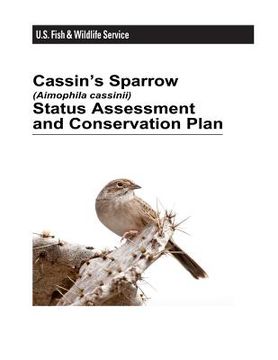Synopsis "Cassin's Sparrow (Aimophila Cassinii) Status Assessment and Conservation Plan"
Cassin's Sparrow (Aimophila cassinii) is a grassland species endemic to the southwestern U.S. and northern Mexico. Its behavior and ecology have been shaped by these arid ecosystems and the health of its populations is dependent on the availability of grasslands that contain a shrub component. Populations of many grassland birds have experienced dramatic declines due to the loss and deterioration of grassland habitats, and there has been concern about the trends in Cassin's Sparrow populations. Without better information about population trends, ecology, and effects of management activities, and without a stronger emphasis on grassland management, Cassin's Sparrows and other grassland species may continue to experience declines. Little information exists about historic Cassin's Sparrow population levels, and current population estimates for states in the breeding range are unknown. Significant survey-wide declines are documented by the Breeding Bird Survey (BBS) between 1966 and 1996. However, closer examination of these data suggest that the survey-wide trends are driven by population declines in the Edwards Plateau and South Texas Brushlands in Texas. No other areas within the core of its range or on the periphery show consistent, significant trends. In fact, there is consensus that in the core of its range in New Mexico Cassin's Sparrow remains the most abundant breeding bird in grasslands with a shrub component. Understanding of population patterns in this species is complicated by large yearly fluctuations in distribution and numbers at any particular location, apparently in response to precipitation. This is particularly obvious in the periphery of its range. These dramatic fluctuations have hampered a clear assessment of population status, and our understanding has been confounded by the fact that the timing of BBS data collection does not always coincide with the peak breeding season of this species. The lack of information about the Cassin's Sparrow's status, ecology, and response to management activities, and the apparent declines indicated by BBS data, have been cause for concern. Habitat disturbance and degradation, mainly due to grazing and rangeland management practices such as shrub control, fire management, and planting of exotics, pose threats to Cassin's Sparrow populations, as does habitat conversion through suburban development and agriculture. There is evidence that heavy grazing negatively affects populations, but the information is primarily available from the southwestern portion of its range (Arizona) and may not be applicable throughout the Cassin's Sparrow's entire range. Any management practice that results in complete removal of the shrub component, or loss of grass cover and an increase in shrub density beyond a threshold preferred by the species, also poses a threat. Lack of standardized or coordinated studies of Cassin's Sparrow ecology and response to management practices in different geographic portions of its range has made it difficult to assess its status and make specific management recommendations. Limited data are available from the wintering grounds, and from its range (both breeding and wintering) in Mexico. The greatest needs are for determining of the causes of significant declines where they occur, determining of the effects of various management activities on Cassin's Sparrow throughout its range, improved assessments of population and trends, and a better understanding of the annual population and distribution dynamics of this species, which shows such dramatic annual distributional fluctuations.

